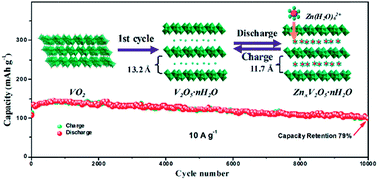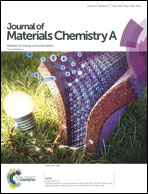An electrochemically induced bilayered structure facilitates long-life zinc storage of vanadium dioxide†
Abstract
Aqueous zinc ion batteries have recently attracted increasing attention due to their high safety, low cost, and high volumetric energy density, but their development is also known to be severely impeded by the shortage of suitable cathode materials that show promising cycling capabilities. Herein we demonstrate an interesting electrochemically induced phase transition from monoclinic VO2 to bilayered V2O5·nH2O during the initial Zn2+ intake/removal, which shows a significantly enlarged interlayer spacing, a reduced structural order, and an excellent structural stability in the following cycling. This open and stable lamellar architecture enables an impressive battery performance: a capacity of 274 mA h g−1, a specific energy density of 271.8 W h kg−1, and an ultra-long lifespan (capacity retention of 79% over 10 000 cycles), which is superior to that of most reported vanadium oxide-based zinc ion batteries.



 Please wait while we load your content...
Please wait while we load your content...